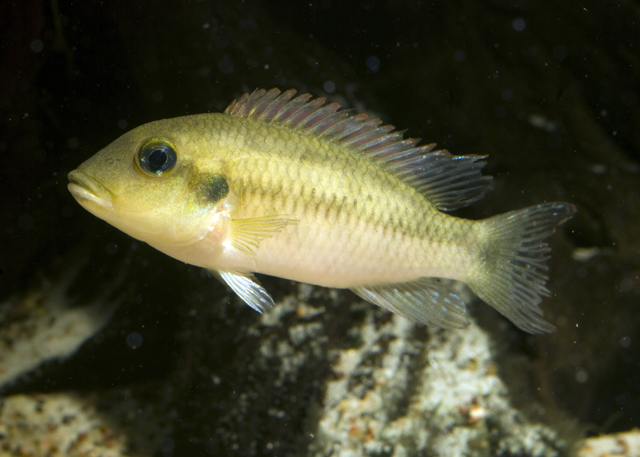| Cichlidae (Cichlids), subfamily: Pseudocrenilabrinae |
| 7.72 cm SL (male/unsexed) |
|
benthopelagic; freshwater; pH range: 7 - 7.5; dH range: 3, |
| Africa: only known from the Mungo and Wouri systems, Cameroon (Ref. 81260). |
|
Dorsal spines (total): 15-16; Dorsal soft rays (total): 10-11; Anal spines: 3-3; Anal soft rays: 7-7. Diagnosis: 20-21 gill rakers on first gill arch; when stressed with 2 continuous dark bands on body; first dorsal fin spine 30-35% length of fifth spine; caudal fin rounded; dorsal head profile moderately convex; iris bright blue; upper lip brown; no black colouration in anterior dorsal fin of juveniles (Ref. 81260).
Description: relatively elongate, gracile species (body depth 31.2-36.2%, mean 33.6% SL); snout moderately long, slightly acute; predorsal profile moderately convex and rounded to dorsal fin origin; caudal peduncle usually deeper than long; 11 tuberculate hypobranchial and ceratobranchial rakers, 9-11 (median 10) lanceolate epibranchial rakers; 1st ray of pelvic fin longest, particularly so in males; some dorsal and anal fin rays elongated; caudal fin slightly rounded in both sexes (Ref. 81260).
Coloration: body light to medium brown, paler ventrally; body scales in males usually darkly marginated (Ref. 52307, 81260). Upper lips brown; cheek, opercle and chest white or light brown (Ref. 81260). Soft dorsal, anal and caudal fins in males with many reddish maculae (Ref. 52307, 81260). Dorsal in most females with black spots which can fuse to form a more or less developed black band along dorsal base, rest of dorsal with white or silvery coloration which is more prominent in spinous portions; dorsal fin and upper part of caudal in males with red margin that is absent or only slightly developed in females; sometimes 2 rows of horizontal black bands on body; iris of the eye is iridescent blue in both sexes (Ref. 81260). Ripe females with a rosy belly (Ref. 52307, 81260) and a rosy iridescent coloration on dorsal fin (Ref. 52307). |
| Feeds mainly on detritus and aufwuchs (Ref. 52307). Pairbonding, ovophilic, biparental mouthbrooder (Ref. 52307, 81260). Maximum TL was recorded at 9.3 cm (Ref. 5616). |
|
Endangered (EN); Date assessed: 16 February 2009 (B1ab(iii)+2ab(iii)) Ref. (130435)
|
| harmless |
Source and more info: www.fishbase.org. For personal, classroom, and other internal use only. Not for publication.

